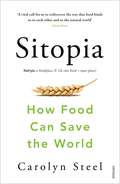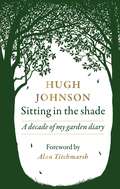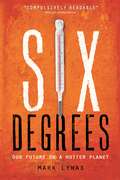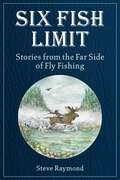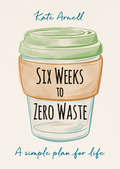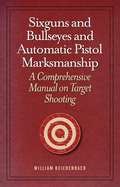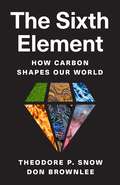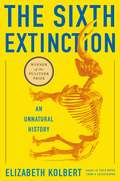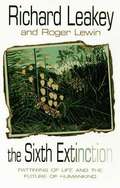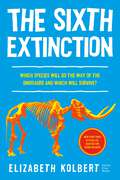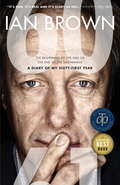- Table View
- List View
Sitopia: How Food Can Save the World
by Carolyn Steel'A visionary look at how quality food should replace money as the new world currency' Tim Spector'Hugely ambitious and beautifully written...destined to become a modern classic' Bee WilsonHow we search for, make and consume food has defined human history. It transforms our bodies and homes, our politics and our trade, our landscapes and our climate. But by forgetting our culinary heritage and relying on cheap, intensively produced food, we have drifted into a way of life that threatens our planet and ourselves.What if there were a more sustainable way to eat and live? Drawing on many disciplines, as well as stories of the farmers, designers and economists who are remaking our relationship with food, this inspiring and deeply thoughtful book gives us a provocative and exhilarating vision for change, and points the way to a better future.'Utterly brilliant' Thomasina MiersWINNER OF THE 2021 GUILD FOOD OF WRITERS AWARD FOR BEST FOOD BOOK*Shortlisted for the Wainwright Prize 2020*
Sitting in the Shade: A decade of my garden diary
by Hugh JohnsonForeword by Alan TitchmarshFor more than 45 years Hugh Johnson has written Trad's Diary, delighting in recording his observations of his own garden, as well as many others, and of the wider natural world. Free to turn his attention to whatever is happening in that season, or simply something that piques his interest, his subjects are as diverse as the sounds of water, forest walks, the names of roses, the taste for shade he shares with Handel, the colours of autumn, the smell of rain, the private garden discovered within Beijing's Forbidden City or the first crocuses of spring. Month by month, Hugh shares with the reader through his easy, evocative writing an eclectic mix of thoughtful, topical and whimsical insights that will delight not only gardeners but anyone with an interest in nature in all its costumes.
Sitting in the Shade: A decade of my garden diary
by Hugh JohnsonForeword by Alan TitchmarshFor more than 45 years Hugh Johnson has written Trad's Diary, delighting in recording his observations of his own garden, as well as many others, and of the wider natural world. Free to turn his attention to whatever is happening in that season, or simply something that piques his interest, his subjects are as diverse as the sounds of water, forest walks, the names of roses, the taste for shade he shares with Handel, the colours of autumn, the smell of rain, the private garden discovered within Beijing's Forbidden City or the first crocuses of spring. Month by month, Hugh shares with the reader through his easy, evocative writing an eclectic mix of thoughtful, topical and whimsical insights that will delight not only gardeners but anyone with an interest in nature in all its costumes.
Six Degrees: Our Future on a Hotter Planet
by Mark LynasSix Degrees' is an eye-opening and vital account of the future of our Earth and our civilisation if current rates of global warming persist. The six degrees of the title refer to the possibility that average temperatures will rise by up to six degrees in the next 100 years.
Six Fish Limit: Stories From the Far Side of Fly Fishing
by Steve RaymondThis collection of six fly-fishing tales, from the best fly-fishing writer in the Pacific Northwest, includes: The Bonefisherman&’s Dilemma: Freddie Woodson planned to write a story about his trip to Sugar Cay Bonefish Resort, sell it to a fishing magazine and use the money to help pay trip expenses. But he didn&’t count on drinking too much rum, falling asleep in a hot tub, meeting a cute native girl or losing the only bonefish he managed to hook, so there was no story and no money. Now he&’s engaged in an increasing-ly acrimonious debate with his tax accountant. Freddie maintains the expenses for his trip should be tax-deductible even without income; his accountant disagrees. With the tax deadline rapidly approaching, Freddie hatches a legally questionable but highly innovative way of deriving some income from the trip. Don&’t try this on your tax return. .2. Welcome to the Stub Mountain Fly Shop: Vicki Brightman has inherited her father&’s financially struggling fly shop, now her sole means of support. Searching desperately for a way to restore the shop&’s financial health, she eventually decides that what works on fish—catching them on artificial flies—also might work on fishermen. With that in mind she concocts a longshot scheme that even she realizes has little chance of working, but with nothing else to do she goes ahead anyway—and the scheme succeeds beyond her wildest dreams. That is, as long as she doesn&’t dream about ethics. 3. The Fishlexic: World-renowned geneticist Timothy Hardhorn dreams of having a son who will grow up to become his lifelong fly-fishing partner, so when his wife becomes pregnant he manipulates the genes in the embryo to assure just such an outcome. When his son, Rodney, is born he soon surpasses his father&’s greatest expectations, but as the boy grows older Timothy notices some things about him that aren&’t, well, quite normal. Eventually he concludes that because of his genetic tinkering, his son has a peculiar form of dyslexia that afflicts only male fly fishers: He believes all the fish he catches are much bigger than they really are. 4. Diary of an Unknown Angler: Andrew Royster, dealer in rare and classic angling books, discovers an old diary containing the answer to one of fly fishing&’s greatest mysteries: the lost identity of the young woman fishing companion of Theodore Gordon, regarded by many asthe patron saint of American fly fishing. Was there something besides fishing going on between those two? Royster can&’t wait to publish the answer, hoping that by doing so he might obtain his own small slice of angling immortality. Then he discovers that once history is made and literature is written, it&’s very hard to change either. 5. The Man in Black Waders (novella): Clint Steele, the world&’s most famous fly fisher, is about to go on trial. He&’s being sued for plagiarism by Mickey Cutter, obscure author of a single angling book, who alleges Steele stole his words and used them in a book of his own. For Steele, the stakes couldn&’t be higher; he could lose lots of money, his reputation, maybe even his livelihood. When the jury returns its verdict Steele does something highly unexpected, apparently uphold-ing the jury&’s verdict. 6. The First Words Ever Written about Fly Fishing: &“I have heard of a Macedonian way of catching fish and it is this.&” Those words, attributed to the Roman scribe Claudius Aelianus, are believed the first ever written about fly fishing. But where did Aelianus hear about the Macedonian way of fishing? Where else but at a meeting of his local fishing club? OK, so it probably didn&’t really happen that way, but who knows? Maybe it did.
Six Weeks to Zero Waste: A simple plan for life
by Kate ArnellWe are in the midst of a worldwide waste epidemic, where the average person in the UK throws away their own body weight in rubbish every seven weeks. The figure looks even worse at national level with the UK producing more than 100 million tonnes of waste every year. We all know the importance of reducing our environmental footprint, but the prospect of going green can seem daunting. Six Weeks to Zero Waste is both an accessible and aspirational programme to eliminate waste - and it goes beyond plastic. In this book, TV presenter turned eco blogger, Kate Arnell, will help you on your path to rubbish-free living, with the principles of the 5 Rs (refuse, reduce, reuse, recycle and rot). From cutting down on food waste and decluttering, to making homemade health and beauty products, you'll soon be on your way to a zero-waste lifestyle.
Six Weeks to Zero Waste: A simple plan for life
by Kate ArnellWe are in the midst of a worldwide waste epidemic, where the average person in the UK throws away their own body weight in rubbish every seven weeks. The figure looks even worse at national level with the UK producing more than 100 million tonnes of waste every year. We all know the importance of reducing our environmental footprint, but the prospect of going green can seem daunting. Six Weeks to Zero Waste is both an accessible and aspirational programme to eliminate waste - and it goes beyond plastic. In this book, TV presenter turned eco blogger, Kate Arnell, will help you on your path to rubbish-free living, with the principles of the 5 Rs (refuse, reduce, reuse, recycle and rot). From cutting down on food waste and decluttering, to making homemade health and beauty products, you'll soon be on your way to a zero-waste lifestyle.
Sixguns and Bullseyes and Automatic Pistol Marksmanship: A Comprehensive Manual on Target Shooting
by William ReichenbachWhether you're a target shooting enthusiast, an experienced shooter, or someone who has never held a gun, Sixguns and Bullseyes and Automatic Pistol Marksmanship will help you explore different types of handguns, fundamental shooting skills, and expert tips to gain marksmanship precision.This edition combines two classic shooting manuals from the 1930s in one volume for modern audiences. Author and gun enthusiast William Reichenbach’s conversational, down-to-earth writing style makes this primer very approachable to all types of readers and shooters. He describes his seven key points—hold, stance, relaxation, moving the gun into position, sighting, squeeze, and breathing—as a basis to target shooting, as well as other topics, including:Ascent to the OlympTime and Rapid FireTrimming Your GunAmmunition WrinklesThe Ideal AutomaticThe “Draw”Preparing for the FrayHomo Sapiens and Other GameComplete with diagrams of important steps and stances as well as illustrations of classic revolvers and automatic pistols, this practical, easy-to-read, and surprisingly timely book will certainly guide interested shooters to that "elusive ten"!
Sixteenth Interim Report of the Committee on Acute Exposure Guideline Levels
by National Research Council of the National AcademiesExtremely hazardous substances (EHSs) can be released accidentally as a result of chemical spills, industrial explosions, and other accidents, or intentionally through terrorist activities. Workers and residents in communities surrounding industrial facilities where EHSs are manufactured, used, or stored and in communities along the nation's railways and highways are potentially at risk of being exposed to airborne EHSs during accidental or intentional releases. To help understand the risk involved with EHSs, the National Advisory Committee (NAC) on Acute Exposure Guideline Levels for Hazardous Substances developed Acute Exposure Guideline Levels (AEGLs) for approximately 200 EHSs. The present volume is the sixteenth interim report evaluating the AEGLs. It summarizes conclusions and recommendations for improving NAC's AEGL documents for 26 chemicals. The report also summarizes the committee's conclusions and recommendations for improving the http://www.nap.edu/catalog.php?record_id=10122 Standing Operating Procedures for Developing Acute Exposure Guideline Levels for Hazardous Substances published in 2001.
The Sixth Element: How Carbon Shapes Our World
by Theodore P. Snow Don BrownleeA cosmic perspective on carbon—its importance in the universe and our livesWhen we think of carbon, we might first think of a simple element near the top of the periodic table: symbol C, atomic number 6. Alternatively, we might think of something more tangible—a sooty piece of coal or a sparkling diamond, both made of carbon. Or, as Earth&’s temperature continues to rise alarmingly, we might think of the role carbon plays in climate change. Yet carbon&’s story begins long ago, far from earthly concerns. In The Sixth Element, astronomers Theodore Snow and Don Brownlee tell the story of carbon from a cosmic perspective—how it was born in the fiery furnaces of stars, what special chemical and physical properties it has, and how it forms the chemical backbone of the planets and all life as we know it. Foundational to every part of our lives, from our bodies to the food, tools, and atmosphere that sustain our existence, carbon is arguably humankind&’s most important element.Snow and Brownlee offer readers the ideal introduction to the starry element that made our world possible and shapes our lives. They first discuss carbon&’s origin, discovery, and unique ability to bond with other elements and form countless molecules. Next, they reveal carbon&’s essential role in the chemical evolution of the universe and the formation and evolution of galaxies, stars, planets, and life, and then, more generally, its technological uses and its influence on Earth&’s climate. Bringing readers on a historical, scientific, and cross-disciplinary journey, The Sixth Element illuminates the cosmic wonder that is carbon.
The Sixth Extinction: An Unnatural History
by Elizabeth KolbertA major book about the future of the world, blending intellectual and natural history and field reporting into a powerful account of the mass extinction unfolding before our eyes.<p><p> Over the last half a billion years, there have been five mass extinctions, when the diversity of life on earth suddenly and dramatically contracted. Scientists around the world are currently monitoring the sixth extinction, predicted to be the most devastating extinction event since the asteroid impact that wiped out the dinosaurs. This time around, the cataclysm is us. <p> In The Sixth Extinction, two-time winner of the National Magazine Award and New Yorker writer Elizabeth Kolbert draws on the work of scores of researchers in half a dozen disciplines, accompanying many of them into the field: geologists who study deep ocean cores, botanists who follow the tree line as it climbs up the Andes, marine biologists who dive off the Great Barrier Reef. She introduces us to a dozen species, some already gone, others facing extinction, including the Panamian golden frog, staghorn coral, the great auk, and the Sumatran rhino. <p> Through these stories, Kolbert provides a moving account of the disappearances occurring all around us and traces the evolution of extinction as concept, from its first articulation by Georges Cuvier in revolutionary Paris up through the present day. The sixth extinction is likely to be mankind's most lasting legacy; as Kolbert observes, it compels us to rethink the fundamental question of what it means to be human. <p> Pulitzer Prize Winner
The Sixth Extinction: Patterns Of Life And The Future Of Humankind
by Roger Lewin Richard E. LeakeyTo the philosophical the earth is eternal, while the human race -- presumptive keeper of the world's history -- is a mere speck in the rich stream of life. It is known that nothing upon Earth is forever; geography, climate, and plant and animal life are all subject to radical change. On five occasions in the past, catastrophic natural events have caused mass extinctions on Earth. But today humans stand alone, in dubious distinction, among Earth's species: "Homo Sapiens possesses the ability to destroy entire species at will, to trigger the sixth extinction in the history of life. In "The Sixth Extinction, Richard Leakey and Roger Lewin consider how the grand sprawl of human life is inexorably wreaking havoc around the world. The authors of "Origins and "Origins Reconsidered, unimpeachable authorities on the human fossil record, turn their attention to the most uncharted anthropological territory of all: the future, and man's role in defining it. According to Leakey and Lewin, man and his surrounding species are end products of history and chance. Now, however, humans have the unique opportunity to recognize their influence on the global ecosystem, and consciously steer the outcome in order to avoid triggering an unimaginable upheaval.
The Sixth Extinction (young readers adaptation): An Unnatural History
by Elizabeth KolbertIn this young readers adaptation of the New York Times-bestselling, Pulitzer Prize-winning The Sixth Extinction, Elizabeth Kolbert tells us why and how human beings have altered life on the planet in a way no species has before. Over the last half-billion years, there have been five mass extinctions, when the diversity of life on earth suddenly and dramatically contracted. Scientists around the world are monitoring the sixth extinction, predicted to be the most devastating extinction event since the asteroid impact that wiped out the dinosaurs. Adapting from her New York Times-bestselling, Pulitzer Prize-winning adult nonfiction, Elizabeth Kolbert explores how humans are altering life on Earth.
Sixty
by Ian BrownFrom the author of the award-winning The Boy in the Moon comes a wickedly honest and brutally funny account of the year in which Ian Brown truly realized that the man in the mirror was actually...sixty. Sixty is a report from the front, a dispatch from the Maginot Line that divides the middle-aged from the soon to be elderly. As Ian writes, "It is the age when the body begins to dominate the mind, or vice versa, when time begins to disappear and loom, but never in a good way, when you have no choice but to admit that people have stopped looking your way, and that in fact they stopped twenty years ago." Ian began keeping a diary with a Facebook post on the morning of February 4, 2014, his sixtieth birthday. As well as keeping a running tally on how he survived the year, Ian explored what being sixty means physically, psychologically and intellectually. "What pleasures are gone forever? Which ones, if any, are left? What did Beethoven, or Schubert, or Jagger, or Henry Moore, or Lucien Freud do after they turned sixty?" And most importantly, "How much life can you live in the fourth quarter, not knowing when the game might end?" With formidable candour, he tries to answer this question: "Does aging and elderliness deserve to be dreaded--and how much of that dread can be held at bay by a reasonable human being?" For that matter, for a man of sixty, what even constitutes reasonableness?From the Hardcover edition.
Sixty Minutes for St. George (Nicholas Everard Naval Thrillers)
by Alexander FullertonChurchill called it the finest feat of arms of the Great War…After a punishing winter patrolling the Strait of Dover aboard HMS Mackerel, Nicholas Everard finds himself leading a secret mission to capture a German trawler. Little does he know it is all in preparation for the Zeebrugge Raid.As dawn breaks on St George’s Day, 1918, the Royal Navy launch a desperate assault on the Belgian submarine base, scuttling multiple blockships to trap the U-boats in the harbour.In sixty minutes of fire and fury, eight Victoria Crosses are won and hundreds of British sailors sink to their deaths. But will Nick be one of them?An extraordinary portrait of violence and valour, perfect for fans of C.S. Forester and Douglas Reeman.Praise for Sixty Minutes for St. George‘The research is unimpeachable and the scent of battle quite overpowering’ The Sunday Times
Sixty Poems: Nineteen Sixty-three To Nineteen Eighty-three
by Charles SimicHere are sixty of Charles Simic's best known poems, collected to celebrate his appointment as the fifteenth Poet Laureate of the United States.
Size- and Age-Related Changes in Tree Structure and Function
by Barbara Lachenbruch Todd E. Dawson Frederick C. MeinzerMillions of trees live and grow all around us, and we all recognize the vital role they play in the world's ecosystems. Publicity campaigns exhort us to plant yet more. Yet until recently comparatively little was known about the root causes of the physical changes that attend their growth. Since trees typically increase in size by three to four orders of magnitude in their journey to maturity, this gap in our knowledge has been a crucial issue to address. Here at last is a synthesis of the current state of our knowledge about both the causes and consequences of ontogenetic changes in key features of tree structure and function. During their ontogeny, trees undergo numerous changes in their physiological function, the structure and mechanical properties of their wood, and overall architecture and allometry. This book examines the central interplay between these changes and tree size and age. It also explores the impact these changes can have, at the level of the individual tree, on the emerging characteristics of forest ecosystems at various stages of their development. The analysis offers an explanation for the importance of discriminating between the varied physical properties arising from the nexus of size and age, as well as highlighting the implications these ontogenetic changes have for commercial forestry and climate change. This important and timely summation of our knowledge base in this area, written by highly respected researchers, will be of huge interest, not only to researchers, but also to forest managers and silviculturists.
The Size of the Risk: Histories of Multiple Use in the Great Basin
by Leisl Carr-ChildersThe Great Basin, a stark and beautiful desert filled with sagebrush deserts and mountain ranges, is the epicenter for public lands conflicts. Arising out of the multiple, often incompatible uses created throughout the twentieth century, these struggles reveal the tension inherent within the multiple use concept, a management philosophy that promises equitable access to the region’s resources and economic gain to those who live there. <p><p> Multiple use was originally conceived as a way to legitimize the historical use of public lands for grazing without precluding future uses, such as outdoor recreation, weapons development, and wildlife management. It was applied to the Great Basin to bring the region, once seen as worthless, into the national economic fold. Land managers, ranchers, mining interests, wilderness and wildlife advocates, outdoor recreationists, and even the military adopted this ideology to accommodate, promote, and sanction a multitude of activities on public lands, particularly those overseen by the Bureau of Land Management. Some of these uses are locally driven and others are nationally mandated, but all have exacted a cost from the region’s human and natural environment. <p><p> In The Size of the Risk, Leisl Carr Childers shows how different constituencies worked to fill the presumed “empty space” of the Great Basin with a variety of land-use regimes that overlapped, conflicted, and ultimately harmed the environment and the people who depended on the region for their livelihoods. She looks at the conflicts that arose from the intersection of an ever-increasing number of activities, such as nuclear testing and wild horse preservation, and how Great Basin residents have navigated these conflicts. <p><p> Carr Childers’s study of multiple use in the Great Basin highlights the complex interplay between the state, society, and the environment, allowing us to better understand the ongoing reality of living in the American West.
Sizing and Selecting Air Pollution Control Systems
by Frank L. Cross Jr. Howard D. HeskethThis book is designed to acquaint the reader with current regulations and with the necessary information to size air pollution control systems. The material presented should also help enable one to select the appropriate equipment for retrofit or new process control, to prepare specifications to purchase equipment, and to prepare permits for air pollution control systems. Sizing and Selecting Air Pollution Control Systems provides guidance to help those responsible for air pollution control to specify systems which are cost-effective and energy-efficient to meet the needs of their employers and the government. When equipment specifications are properly prepared, they provide for an easier comparison of competitive bids of those devices capable of meeting standards reliably and economically.
Skandar and the Phantom Rider: the spectacular sequel to Skandar and the Unicorn Thief, the biggest fantasy adventure since Harry Potter (Skandar #2)
by A.F. SteadmanHEROES AND UNICORNS AS YOU&’VE NEVER SEEN THEM BEFORE. The epic adventure continues . . . Don&’t miss this sequel to Waterstones Children&’s Book of the Year 2022 Skandar and the Unicorn Thief. Skandar and the Phantom Rider is the second book in the international bestselling SKANDAR series, an unmissable adventure for listeners age 9 to 99 and fans of Harry Potter, Percy Jackson, Eragon and Fireborn.The Island shall have its revenge . . . Skandar Smith has achieved his dream to train as a unicorn rider. But as Skandar and his friends enter their second year at the Eyrie, a new threat arises. Immortal wild unicorns are somehow being killed, a prophecy warns of terrible danger, and elemental destruction begins to ravage the Island. Meanwhile, Skandar&’s sister, Kenna, longs to join him – and Skandar is determined to help her, no matter what. As the storm gathers, can Skandar discover how to stop the Island tearing itself apart – before it&’s too late for them all? THE EPIC ADVENTURE CONTINUES... PRE-ORDER SKANDAR AND THE CHAOS TRIALS, THE UNMISSABLE BRAND NEW BOOK IN THE SERIES, NOW!ONE OF THE THE SUNDAY TIMES BEST BOOKS FOR CHILDREN 2023SKANDAR AND THE UNICORN THIEF WAS THE WINNER OF THE INDIE BOOK AWARDS 2023 Praise for the SKANDAR series:&‘Skandar Smith&’s adventures at the Eyrie, a training school for unicorn riders, have made him the most popular children&’s fantasy hero since Harry Potter.&’ - The Daily Telegraph'Epic, unforgettable and endlessly exciting, Steadman&’s masterful sequel soars even higher than her debut.' – Aisling Fowler, author of the Fireborn series 'Steadman has a vast imagination, her world-building is a joy, the battle scenes are thrilling and her characters charm.' – The Times Children's Book of the Week&‘Pacy, enthralling and epic, a gripping read.&’ – Louie Stowell, author of Loki and Otherland &‘A dazzling feat of imagination. I loved every breathless moment of it!&’ – Cat Doyle, author of The Storm Keeper&’s Island and co-author of Twin Crowns&‘The best book I&’ve ever read.&’ – Patrick, age 10&‘My book of the year. Not since Harry Potter have I felt this excited about a series. Readers are sure to be clamouring for the next book. You&’ll never look at unicorns the same way again, nor will you want to!&’ – Dominique Valente, author of the Starfell series&‘Never have unicorns been so ferocious, fearsome and thrilling! A fantastically gripping read!&’ – Laura Ellen Anderson, author of Amelia Fang and Rainbow Grey&‘A magnificent book. I raced through it – at turns enthralled, delighted, amazed. It&’s everything I could have wanted and more. No doubt this book is going to fly.&’ – Hannah Gold, author of The Last Bear'Perfect for those who have consumed the Harry Potter books and Philip Pullman&’s His Dark Materials trilogy and are looking for their next fictional feast.' – The Sunday Times
Skateboarding For Dummies
by Daewon SongA beginner’s guide to skating for fun, fitness, and self-expression Skateboarding For Dummies teaches you the basics of the fun and popular sport of skateboarding, so you can start shredding. Author Daewon Song has been a pro skateboarder for 30 years and is considered to be the most technically gifted skateboarder of all time. He is passionate about the sport and shares his enthusiasm and experience in this easy-to-read guide. Skateboarding is a fun, challenging, and inclusive sport that can also be a powerful outlet for self-expression. With this book, you’ll learn cool tricks, safe skating, and skatepark etiquette. Plus, you’ll discover how skateboarding can bring positivity to your life, building your confidence and self-esteem. Shop for your first skateboard and essential accessories Learn the basics of riding a skateboard at a skatepark Get step-by-step instructions for performing classic tricks Discover the history of skateboardingSkateboarding is for everyone, regardless of age or background, and Skateboarding For Dummies is for anyone who wants to give this sport a try.
Skating (Merit Badge Series)
by Boy Scouts of AmericaSkating activities present inherent safety concerns, primarily the risk of falls and collisions. The guidelines in this book emphasize prevention and are meant to cover all BSA skating programs. Scouts should always practice safety and courtesy and obey all local and rink or park rules. Every Skating merit badge program or activity must follow the BSA guidelines, which are set forth in the Guide to Safe Scouting and are repeated here.
Skeeter
by Kay Jordan SmithThe adventures of two young boys befriended by an old black man who is a legendary hunter.
The Skeptical Environmentalist: Measuring the Real State of the World
by Bjørn LomborgThe Skeptical Environmentalist challenges widely held beliefs that the environmental situation is getting worse and worse and is critical of the way in which many environmental organizations make selective and misleading use of the scientific evidence. Using the best available statistical information from internationally recognized research institutes, it systematically examines a range of major environmental problems that feature prominently in headline news across the world.
Skiing into the Bright Open: My Solo Journey to the South Pole
by Liv ArnesenThe first woman to ski solo to the South Pole tells the story of what it took to get there At home in Norway it is eight o&’clock on Christmas Eve night, but ahead, at the Amundsen–Scott base that has been visible for hours, it is already early in the morning of Christmas Day when Liv Arnesen, after skiing solo for 745 miles in fifty days, finally arrives. She had been dreaming of the South Pole for most of her forty-one years, and now, even in her joy at having reached her goal in December 1994, she has to ask herself: what took you so long? In Skiing into the Bright Open Arnesen describes the exhausting, exhilarating experience of being the first known woman to ski unsupported to the South Pole. She also answers her own question, framing her account of her historic expedition with her longtime struggle to find the freedom and confidence to follow her dreams into uncharted territory. From her childhood in Norway to the seasons she spent working as a guide on Svalbard, the Norwegian archipelago in the Arctic Ocean, Arnesen courted the cold, and her memoir reflects the knowledge and passion for Arctic and Antarctic exploration that grew with her adventures in the wintry reaches of Norway and beyond. Tracing her path from the heroic stories of explorers like Fridtjof Nansen and Ernest Shackleton to her own crossing of the Greenland Ice Cap in 1992, Arnesen credits the inspiring feats of those who preceded her but also describes the obstacles—including niggling self-doubt—that tradition, convention, and downright prejudice put in her way as she endeavored to find the support and sponsorship granted to men in her field.A tale of solitary adventure in the bleak and beautiful bone-chilling cold of Antarctica, Skiing into the Bright Open tells a story of gritty determination, thrilling achievement, and perseverance in the face of near despair and daunting odds; it is, ultimately, an object lesson in the power of a dream if one is willing to pursue it to the ends of the earth.
